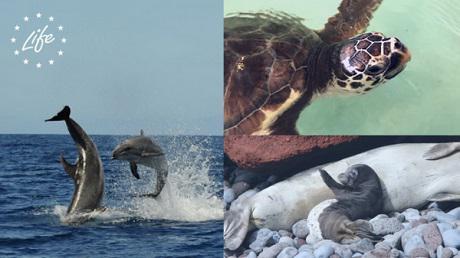
Oceans are the world’s largest ecosystem. But they are being polluted and damaged at an alarming rate and this is having a devastating impact on marine life. Several LIFE projects are working hard to reverse this worrying trend.
Despite the EU having some of the most ambitious marine environmental protection laws in the world, excess nutrients, underwater noise, plastic and overfishing remain a big problem.
Below are six LIFE projects that are doing their utmost to protect and restore our precious marine life.
Tracking the elusive harbour porpoise
Harbour porpoises are shy sea mammals, whose populations in the Baltic Sea were for decades decreasing sharply. For two years, the LIFE+ Sambah project collected data on these mammals by monitoring their sounds using cutting edge technology. The team established that there were some 450 of them in the Baltic sea and that numbers were dwindling mainly due to fishing nets and pollution. Based on the project’s findings, the Swedish government designated a large marine Natura 2000 network site in the Baltic Sea for the mammals. The project’s approach can also be used by other countries wanting to find out more about their own marine life.

Saving one of the world’s rarest seals
The Mediterranean monk seal is one of the most endangered mammals in the world. The LIFE Madeira Monk Seal project set out to improve awareness of this seal and to ensure its long-term survival. To this end, the project team set up a monitoring system to establish how many monk seals there are, where they live, where they feed and what kind of problems they face. The team also developed an action plan, setting out measures to eliminate threats. Numbers have risen steadily – from just six individuals in 1988 to 20 in 2018.

The bottlenose dolphin gets a helping hand
The growing popularity of whale-watching coupled with a rise in ships off the coast of the Madeira islands are threatening the bottlenose dolphin’s survival. LIFE CETACEOSMADEIRA II aimed to alleviate the pressure on this dolphin by firstly studying how likely it was to become extinct in the near future. The team also identified where the species can usually be found in Madeira’s waters. They also worked successfully with whale watching companies to improve the sustainability of their tours for tourists.

Restoring a reef in the Kattegat sea
One of the oldest ecosystems on earth, reefs are also biodiversity hotspots. In Denmark, they have however been exploited with some 34 km² of boulders from reefs being excavated over the years (an area the size of roughly 6350 football fields). The LIFE BLUEREEF project aimed to restore a so-called cavernous boulder reef offshore habitat in the Kattegat bay. The project achieved this feat by transporting natural boulders from a quarry in Norway and placing them in the project area. The work had an immediate effect on the fish populations, with numbers of cod increasing by up to 600%. Harbour porpoises are frequently using the reef, while fauna and vegetation are flourishing.
Protecting dolphins from the perils of fishing nets
When dolphins become trapped in fishing nets, it is not only their lives that are in danger. So are the lives of other fish who they either eat or injure. Moreover, the nets are inevitably damaged, causing financial losses for the fishermen. The new LIFE DELFI project aims to reduce these dolphin-net interactions. To this end, the team is placing both acoustic and visual dolphin deterrents in the water. In addition, a compensation scheme is to be rolled out to help fishermen suffering from the economic losses caused by dolphins. These fishermen will also be encouraged to launch dolphin watching tours so that they can make more money.

Multi-country campaign to save two species of sea turtles
Sea turtles are losing their habitats mainly due to tourism and getting tangled up in fishing gear. Building on the successful LIFE EUROTURTLES project, LIFE MEDTURTLES aims to improve the conservation status of the loggerhead sea turtle and the green sea turtle in ten Mediterranean countries. It also plans on removing abandoned fishing gear from the seabed, while carrying out aerial surveys and tracking to establish turtle hotspots. Training is on offer to help rescue workers and fishermen recover and treat injured turtles.

Details
- Publication date
- 27 October 2020
- Author
- Executive Agency for Small and Medium-sized Enterprises

